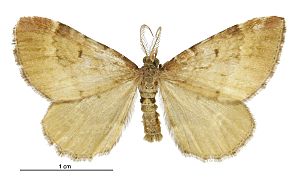Asaphodes imperfecta facts for kids
Quick facts for kids Asaphodes imperfecta |
|
|---|---|
 |
|
| Male | |
| Conservation status | |
 Nationally Critical (NZ TCS) |
|
| Scientific classification | |
| Genus: |
Asaphodes
|
| Species: |
imperfecta
|
| Synonyms | |
|
|
The Asaphodes imperfecta is a type of moth that belongs to the Geometridae family. This special moth lives only in New Zealand, meaning it is endemic. Sadly, the Department of Conservation says it is critically endangered.
Contents
How Scientists Named the Moth
This moth was first studied and named in 1905. A scientist named Alfred Philpott gave it the name Xanthorhoe imperfecta. He found examples of the moth in a place called West Plains, near Invercargill. Later, in 1971, another scientist, John S. Dugdale, changed its name. He moved it to a different group, or genus, called Asaphodes.
What Does the Asaphodes imperfecta Moth Look Like?
The Asaphodes imperfecta moth is about 29 millimeters (just over an inch) wide. Its head, body, and abdomen are a brownish-yellow color.
Male and Female Moth Differences
The male moths often have reddish areas. These are usually found along the front edge of their wings and near the tips. The female moths have very faint wavy lines across their wings. Both male and female moths have small white spots. These spots are often found after the darker spots along the front edge of the wings. There is also a clear pair of white spots about two-thirds of the way along the wing. The edges of their wings, called cilia, are yellowish. They also have some dark, blackish bars.
Hind Wings of the Moth
The back wings of the moth are also yellowish. The cilia on these wings are a grayish-yellow color, mixed with some darker shades.
Where Does the Asaphodes imperfecta Moth Live?
The Asaphodes imperfecta moth is endemic to New Zealand. This means it is found naturally nowhere else in the world. It used to be thought that this moth was rare. It was only found in a few specific places in the southern part of the South Island. Sadly, it is now believed to be completely gone from its original home in Invercargill. Another scientist, George Vernon Hudson, also noted that it was present in Dunedin.
Moth's Home and Habits
Adult Asaphodes imperfecta moths have been found living in forests. George Hudson said that these moths especially liked low-lying, wet forest areas. These are often called swampy forests. Hudson also observed that adult moths were flying around during December and January.
What Do These Moths Eat?
Scientists do not yet know what plants the caterpillars of this moth eat. These are called the host plants.
Why This Moth is Critically Endangered
This moth is classified as "Nationally Critical" by the New Zealand Threat Classification system. This is the highest level of threat for species in New Zealand. Scientists believe this moth is in danger mainly because it is losing its home. Many wetlands, which are wet areas like swamps, have been drained. When wetlands dry out, they can no longer support the plants that the moth's larvae (young stage) need to survive.
Images for kids


